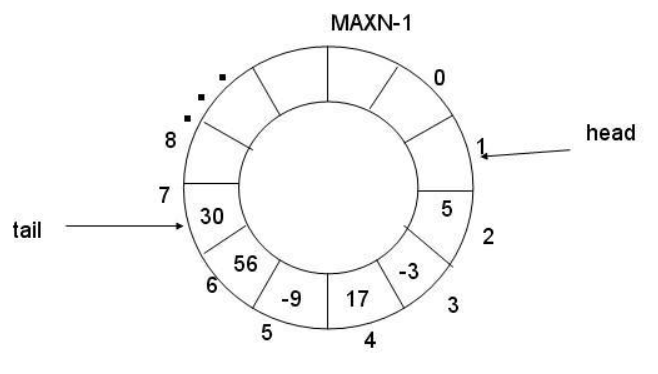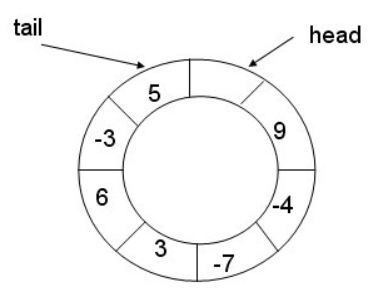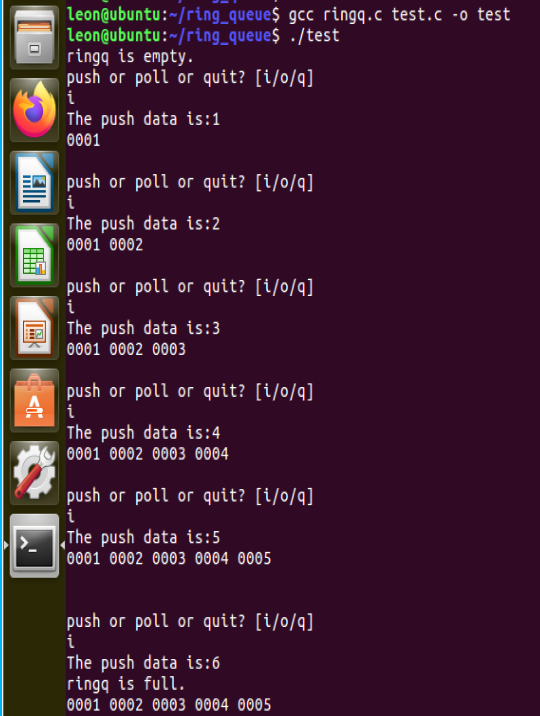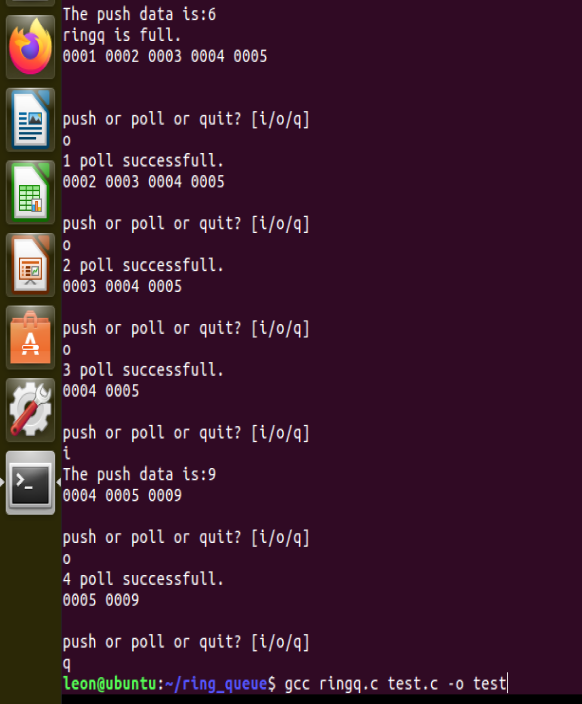它逻辑上是一个首尾相连的FIFO结构,具体实现上采用简单的线性数组。通过额外的辅助标志(head、tail)能很快知道队列的使用情况(是满还是为空)。正因为其简单高效的原因,甚至在硬件都实现了环形队列。
环形队列广泛用于网络数据收发、程序间的大量数据交换(比如内核与应用程)、硬件接收大量数据。
1、环形缓冲区原理

- 环列队列逻辑上将数组元素array[0]与array[LEN-1]连接起来,形成一个存放队列的环形空间。实际操作中为了方便读写,采用head和tail分别指向可以读的位置和可以写的位置。
- 环形队列的关键是判断队列为空,还是为满。一般有两种方法:
- 一是附加一个标志位tag
- 当head赶上tail,队列空,则令tag=0
- 当tail赶上head,队列满,则令tag=1
- 二是在队尾结点与队首结点之间留有1个元素的空间
- 队列空: head==tail
- 队列满: (tail+1)% MAXN ==head
2、预留1个空位的环形队列
- 开始时head和tail指向同一个地址,但随着数据的push和poll,head和tail之间永远预留一个单元空间。如下图所示即为一个满队列。但箭头所指的位置不准确。tail应该指向空位,head指向9。即从头出去,从尾巴进来。

- 数据结构:
struct ring_queue{
unsigned int head;
unsigned int tail;
unsigned int size; //环形缓冲区容量
int *array; //实际缓冲区(数组)的首地址
};
- 规则:
- head指向可读位置(地址存有数据),tail指向可写位置(地址无数据)。
- 初始化状态: head = tail = 0;
- 判定队列为空:head == tail
- 队列为满:**( (tail+1) % SIZE ) == head **
- 入队操作:若队列不满,则写入。
- 出队操作:若队列不空,则读出。
- 缓冲区必须是连续的内存空间,可以通过静态数组变量或局部数组变量的方式定义,但绝不能从堆上分配(malloc),因为malloc分配的内存空间是不连续的!!!
- 头文件:
#ifndef __RINGQ_H__
#define __RINGQ_H__
#ifdef __cplusplus
extern "C" {
#endif
typedef struct {
unsigned int head;
unsigned int tail;
unsigned int size;
int *array;
}RINGQ;
#define ringq_is_empty(q) (q->head == q->tail)
#define ringq_is_full(q) (((q->tail+1)%q->size) == q->head )
int ringq_init(RINGQ * ringqp, int * array_ptr, unsigned size);
int ringq_free(RINGQ * ringqp);
int ringq_push(RINGQ * ringqp,int data);
int ringq_poll(RINGQ * ringqp,int * val);
void ringq_display(RINGQ * ringqp);
#ifdef __cplusplus
}
#endif
#endif
- c文件:
1 #include <stdio.h>
2 #include <stdlib.h>
3 #include "ringq.h"
4
5 int ringq_init(RINGQ * ringqp, int * array_ptr, unsigned size)
6 {
7 /*
8 不能从堆里分配空间!!!
9 因为堆里的空间不是连续的,而是通过链表链接的一个空间串
10 if(!(ringqp->array = (int *)malloc(size))){
11 printf("Malloc failed!\n");
12 return -1;
13 }
14 */
15 ringqp->array = array_ptr;
16 ringqp->size = size;
17 ringqp->head = 0;
18 ringqp->tail = 0;
19 return 0;
20 }
21
22 int ringq_free(RINGQ * ringqp)
23 {
24 free(ringqp->array);
25 return 0;
26 }
27
28
29 int ringq_push(RINGQ * ringqp,int data)
30 {
31 if(ringq_is_full(ringqp))
32 {
33 printf("ringq is full.\n");
34 return -2;
35 }
36 ringqp->array[ringqp->tail] = data;
37 ringqp->tail = (ringqp->tail + 1) % ringqp->size ;
38 return 0;
39 }
40
41
42 int ringq_poll(RINGQ * ringqp,int * val)
43 {
44 if(ringq_is_empty(ringqp))
45 {
46 printf("ringq is empty.\n");
47 return -3;
48 }
49 *val = ringqp->array[ringqp->head];
50 ringqp->head = (ringqp->head + 1) % ringqp->size ;
51 return 0;
52 }
53
54 void ringq_display(RINGQ * ringqp)
55 {
56 int i =0;
57 unsigned head = ringqp->head;
58 unsigned tail = ringqp->tail;
59 unsigned size = ringqp->size;
60
61 if(ringq_is_empty(ringqp))
62 {
63 printf("ringq is empty.\n");
64 return;
65 }
66 while(head != tail){
67 printf("%04d ",ringqp->array[head]);
68 i++;
69 if(i == 5){
70 printf("\n");
71 i = 0;
72 }
73 head = (head + 1)%(size);
74 }
75 printf("\n");
76 return;
77 }
- 测试文件:
1 #include <stdio.h>
2 #include <stdlib.h>
3 #include "ringq.h"
4
5 #define RQ_SIZE 50
6
7 int main(void)
8 {
9 int data_in = 0;
10 int data_out = 0;
11 int select = 0;
12
13 int array[RQ_SIZE]={};
14 RINGQ rq, *rqp;
15 rqp = &rq;
16
17 ringq_init(rqp, array, RQ_SIZE);
18 ringq_display(rqp);
19
20 int index = RQ_SIZE - 1; //allways a bank between head and tail
21 while (index > 0){
22 ringq_push(rqp,1);
23 index -= 1;
24 }
25
26 ringq_display(rqp);
27
28 while (index < RQ_SIZE-1){
29 ringq_poll(rqp,&data_out);
30 index += 1;
31 }
32
33 ringq_display(rqp);
34
35 while (index > 0){
36 ringq_push(rqp,2);
37 index -= 1;
38 }
39
40 ringq_display(rqp);
41
42 return 0;
43 }
- 实验结果:

- 测试文件2
1 #include <stdio.h>
2 #include <stdlib.h>
3 #include "ringq.h"
4
5 #define RQ_SIZE 5
6
7 int main(void)
8 {
9 int data_in = 0;
10 int data_out = 0;
11 int select = 0;
12
13 int array[RQ_SIZE]={};
14 RINGQ rq, *rqp;
15 rqp = &rq;
16
17 ringq_init(rqp, array, RQ_SIZE);
18 ringq_display(rqp);
19
42
43 loop: puts("push or poll or quit? [i/o/q]");
44 select = getchar();
45 getchar(); //丢弃回车
46 switch(select){
47 case 'i':
48 printf("The push data is:");
49 scanf("%d",&data_in);
50 getchar(); //丢弃回车
51 ringq_push(rqp, data_in);
52 break;
53 case 'o':
54 ringq_poll(rqp, &data_out);
55 printf("%d poll successfull.\n",data_out);
56 break;
57 case 'q':
58
59 return 0;
60 default:
61 printf("Wrong choice!enter i or o!\n");
62 }
63 ringq_display(rqp);
64 printf("\n");
65 goto loop;
66 }
- 实验结果:


- 有关getchar()和输入缓冲区的关系,请查看一文搞懂getchar()和putchar()的奇怪现象_Leon的博客-CSDN博客或者C语言 getchar()原理及易错点解析_Kevin.wang-CSDN博客_c语言getchar
3、附加满空标志位的环形队列
- 数据结构
typedef struct ringq{
int head;
int tail;
int tag ;
int size ;
int space[RINGQ_MAX];
}RINGQ;
- 规则
- 初始化状态: q->head = q->tail = q->tag = 0;
- 队列为空:(q->head == q->tail) && (q->tag == 0)
- 队列为满**: ((q->head == q->tail) && (q->tag == 1))**
- 入队操作:如队列不满,则写入q->tail = (q->tail + 1) % q->size ;
- 出队操作:如果队列不空,则从head处读出。下一个可读的位置在 q->head = (q->head + 1) % q->size
- 头文件
#ifndef __RINGQ_H__
#define __RINGQ_H__
#ifdef __cplusplus
extern "C" {
#endif
#define QUEUE_MAX 20
typedef struct ringq{
int head;
int tail;
int tag ;
int size ;
int space[QUEUE_MAX];
}RINGQ;
extern int ringq_init(RINGQ * p_queue);
extern int ringq_free(RINGQ * p_queue);
extern int ringq_push(RINGQ * p_queue,int data);
extern int ringq_poll(RINGQ * p_queue,int *p_data);
#define ringq_is_empty(q) ( (q->head == q->tail) && (q->tag == 0))
#define ringq_is_full(q) ( (q->head == q->tail) && (q->tag == 1))
#define print_ringq(q) printf("ring head %d,tail %d,tag %d\n", q->head,q->tail,q->tag);
#ifdef __cplusplus
}
#endif
#endif
- 实现代码
#include <stdio.h>
#include "ringq.h"
int ringq_init(RINGQ * p_queue)
{
p_queue->size = QUEUE_MAX ;
p_queue->head = 0;
p_queue->tail = 0;
p_queue->tag = 0;
return 0;
}
int ringq_free(RINGQ * p_queue)
{
return 0;
}
//Write data to the queue
int ringq_push(RINGQ * p_queue,int data)
{
print_ringq(p_queue);
if(ringq_is_full(p_queue))
{
printf("ringq is full\n");
return -1;
}
p_queue->space[p_queue->tail] = data;
p_queue->tail = (p_queue->tail + 1) % p_queue->size ;
if(p_queue->tail == p_queue->head)
{
p_queue->tag = 1;
}
return p_queue->tag ;
}
//Get data from the queue
int ringq_poll(RINGQ * p_queue,int * p_data)
{
print_ringq(p_queue);
if(ringq_is_empty(p_queue))
{
printf("ringq is empty\n");
return -1;
}
*p_data = p_queue->space[p_queue->head];
p_queue->head = (p_queue->head + 1) % p_queue->size ;
if(p_queue->tail == p_queue->head)
{
p_queue->tag = 0;
}
return p_queue->tag ;
}
- 测试代码
//请参考上节的test.c